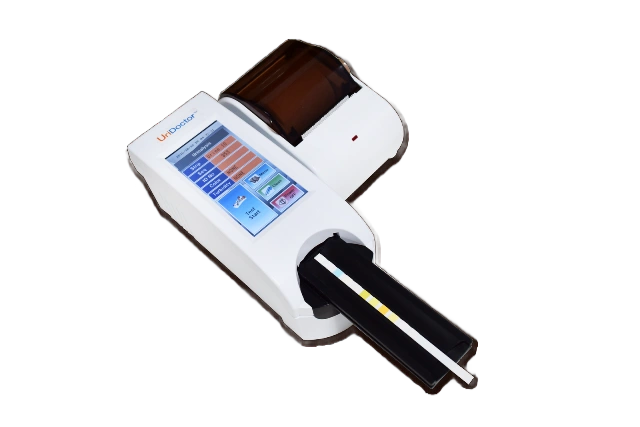
For the pharmacist, it represents a key resource to support the patient's health, allowing examinations and follow-ups to be performed easily and quickly.
The device performs chemical-physical screening, microalbumin and creatinine dosing, as well as free radical testing, providing a complete picture of metabolic, renal, hepatic, acid-base balance and urinary tract infection status. The results, both qualitative and quantitative, show the presence of unwanted substances and, if necessary, quantify them precisely.
STRIPS AVAILABLE
Strips 11: 25 strips for simultaneous analysis of pH, specific gravity, leukocytes, nitrites, proteins, blood, bilirubin, urobilinogen, glucose, ketones and ascorbic acid.
The urine test is an essential test to evaluate the general state of health and to detect possible pathologies in the kidneys and urinary tract. It is also essential for the evaluation of sports fitness, the follow-up of the evolution of various diseases and the monitoring of the efficacy of treatments.
2AC strips: 25 strips for the analysis of microalbumin, creatinine and their ratio.
Microalbumin: early indicator of renal failure often associated with chronic diseases such as diabetes and hypertension.
Creatinine: "waste" product of creatine, a protein used by the human body to produce energy. Creatinine is expelled through urine. Its values indicate good renal function.
Microalbumin/creatinine ratio: test recommended by the ADA*, as an early indicator of diabetic nephropathy (*American Diabetes Association).
EQC: On-board electronic control for monitoring the optical module, ensuring consistent and accurate results.
Self-diagnosis: Automatic verification of device functionality, ensuring optimal performance at all times.
Automatic calibration: Self-calibration through the recognition of QR codes, present on each card, for effortless accuracy.
Alignment with the central laboratory: Possibility to adjust the calibration coefficients for each analyte, allowing the system to be aligned with the central laboratory reference instruments.

It uses reflection photometry to analyze urine samples, ensuring accurate and fast results.
It allows up to 45 tests in normal mode and 120 tests in fast mode, optimizing workflow in clinical environments.
It has a storage capacity for up to 2,000 results, facilitating the tracking and management of patient data.
It has a USB port that allows data transfer and connection to other devices for efficient information management.
Compact and lightweight design, with a weight of 460 grams and dimensions of 188x74x77 mm, facilitating portability and use in various environments.
It operates with a 100-240V power supply or with 12V batteries, offering flexibility in its use according to the user's needs.
It requires eight AAA 1.5V batteries for operation in portable mode, ensuring its operability in situations where there is no access to a power source.
It offers the option of connecting an external printer for direct printing of the results, facilitating the documentation and recording of the tests performed.